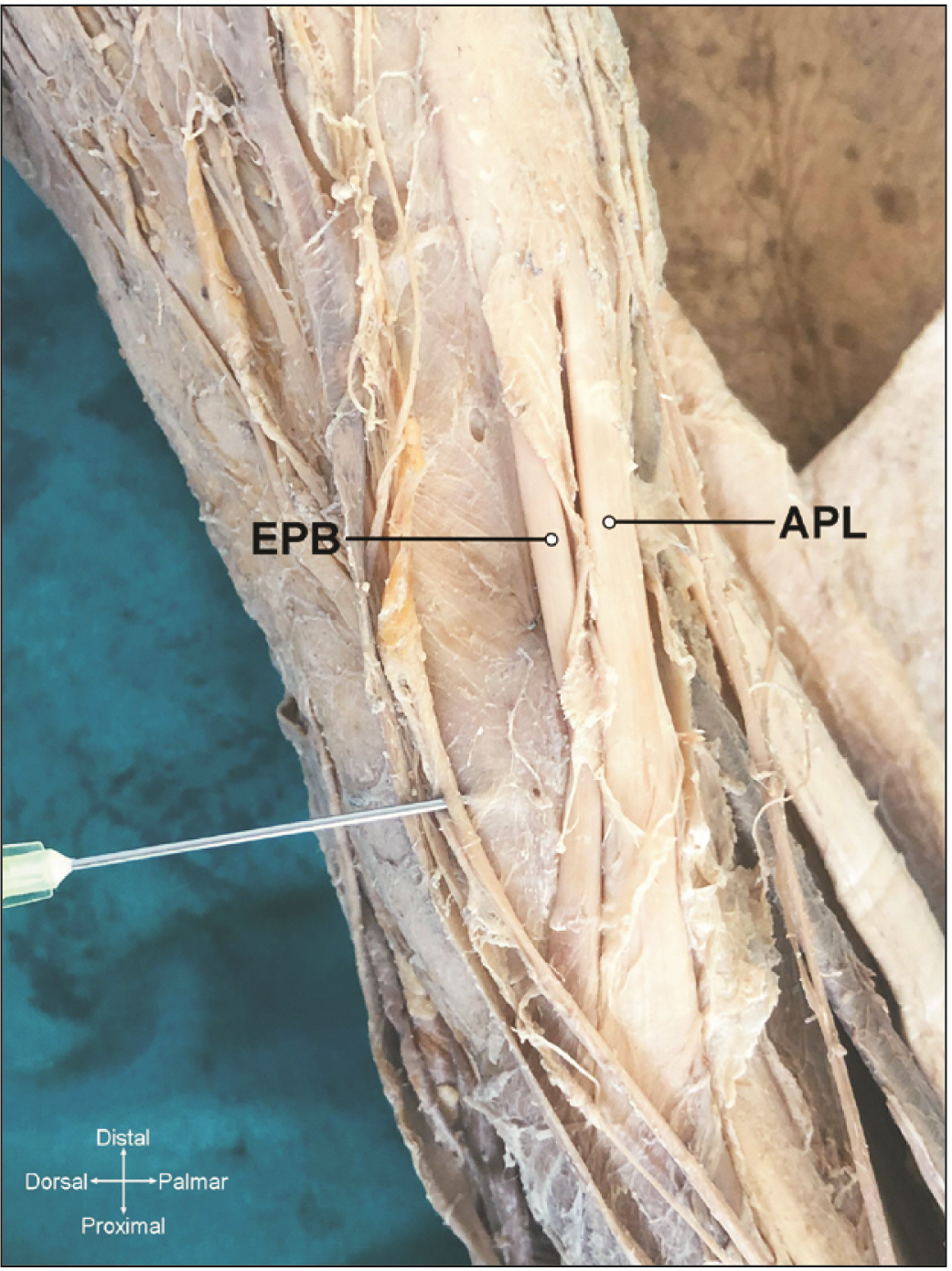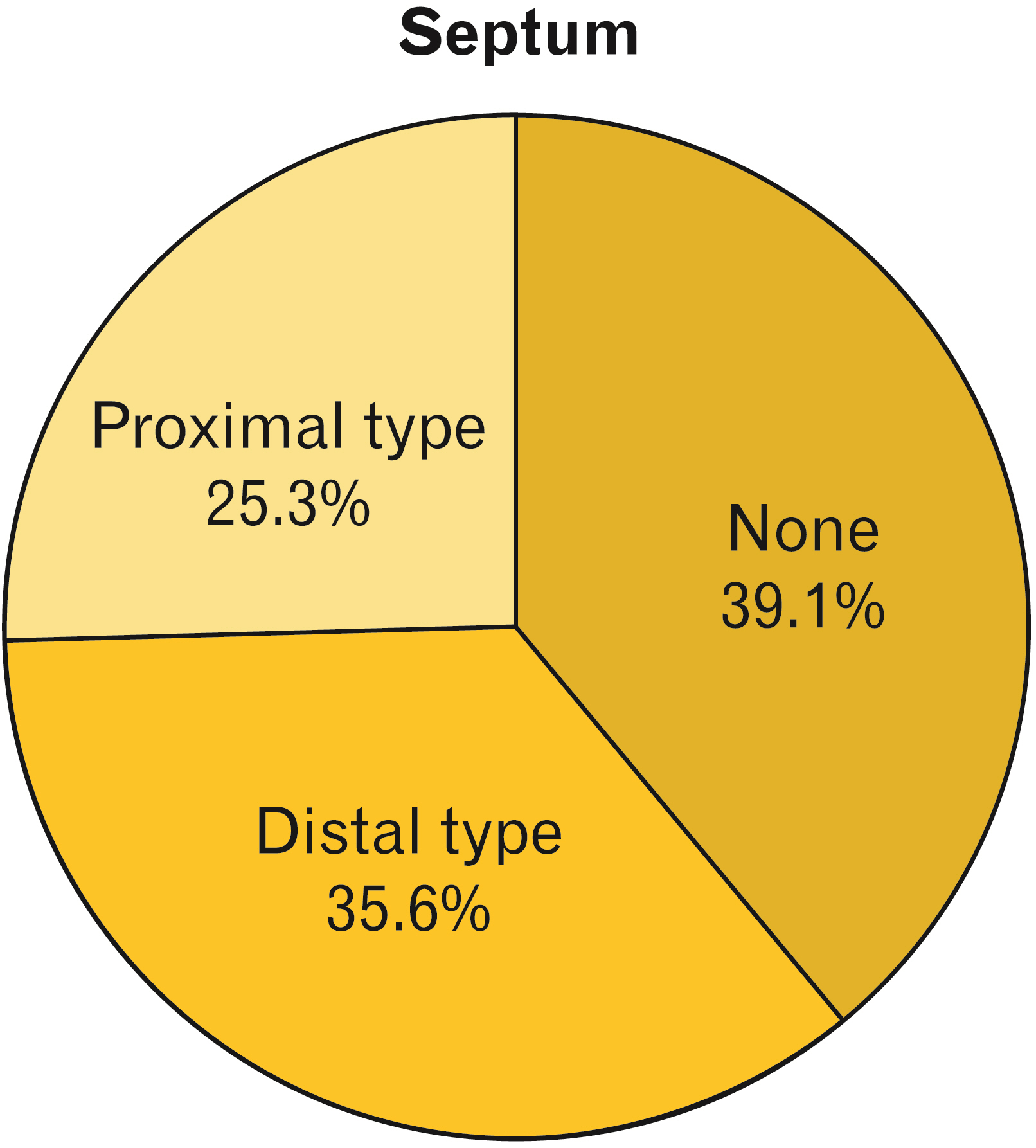Anat Cell Biol.
2023 Sep;56(3):328-333. 10.5115/acb.23.008.
First extensor compartment morphology and clinical significance: a cadaver series study
- Affiliations
-
- 1Department of Anatomy, Istanbul Faculty of Medicine, Istanbul University, Istanbul, Turkey
- 2Department of Anatomy, Faculty of Medicine, Koc University, Istanbul, Turkey
- KMID: 2546460
- DOI: http://doi.org/10.5115/acb.23.008
Abstract
- The first extensor compartment of the wrist is a distinctly variable anatomical area. Anatomical variations in this region contribute to the pathophysiology and treatment failure of de Quervain’s disease, which is a kind of tenosynovitis that develops in the first extensor compartment of the wrist. We aim to describe the first extensor compartment morphology, to evaluate the septum frequency, location of the septum, and the number of tendons of abductor pollicis longus (APL) and extensor pollicis brevis muscles (EPB). First extensor compartment of 87 wrists of 45 cadavers were dissected. The presence or absence of septum and number of tendon slips of APL and EPB revealed. The proximal and distal widths of the compartments were measured. Septums were detected in 60.9% (n=53) of the wrists. Incomplete (distal) and complete (proximal) septa were present in 35.6% (n=31) and 25.3% (n=22) of the cases. Only 26.4% of the wrists had a single slip of APL tendon. The Remaining had multiple slips. The median inner width of the proximal and distal compartments in all wrists were calculated as in the order of 9.11±1.14 mm and 8.55±1.12 mm. We believe that understanding the anatomy of the first extensor compartment in the Turkish population would be helpful to surgeons, radiologists, and physiotherapists to diagnose and manage de Quervain’s disease.
Figure
Cited by 1 articles
-
Relationship to the superficial radial nerve and anatomic variations of the first extensor compartment in Thai population: a basis for successful de Quervain tenosynovitis treatment
Krittameth Pasiphol, Sithiporn Agthong, Napatpong Thamrongskulsiri, Sirikorn Dokthien, Thanasil Huanmanop, Tanat Tabtieng, Vilai Chentanez
Anat Cell Biol. 2024;57(2):246-255. doi: 10.5115/acb.24.011.
Reference
-
References
1. Anson BJ. 1963. An atlas of human anatomy. 2nd ed. Saunders;180e1. DOI: 10.7326/0003-4819-59-1-129_1.2. Netter FH. M Cumhur . 2015. Human anatomy atlas. 6th ed. Nobel Tıp Kitabevleri;p. 457. Turkish.3. Pollack HJ. 1978; Variations of the first extensor tendon compartment and their significance in the surgical therapy of Quervain's disease. Beitr Orthop Traumatol. 25:148–50. German. PMID: 656035.4. Jackson WT, Viegas SF, Coon TM, Stimpson KD, Frogameni AD, Simpson JM. 1986; Anatomical variations in the first extensor compartment of the wrist. A clinical and anatomical study. J Bone Joint Surg Am. 68:923–6. DOI: 10.2106/00004623-198668060-00016. PMID: 3733780.
Article5. Gao ZY, Tao H, Xu H, Xue JQ, Ou-Yang Y, Wu JX. 2017; A novel classification of the anatomical variations of the first extensor compartment. Medicine (Baltimore). 96:e7875. DOI: 10.1097/MD.0000000000007875. PMID: 28858099. PMCID: PMC5585493.
Article6. Gurses IA, Coskun O, Gayretli O, Kale A, Ozturk A. 2015; The anatomy of the fibrous and osseous components of the first extensor compartment of the wrist: a cadaveric study. Surg Radiol Anat. 37:773–7. DOI: 10.1007/s00276-015-1439-2. PMID: 25645546.
Article7. Clarke MT, Lyall HA, Grant JW, Matthewson MH. 1998; The histopathology of de Quervain's disease. J Hand Surg Br. 23:732–4. DOI: 10.1016/S0266-7681(98)80085-5. PMID: 9888670.
Article8. Canale ST, Azar FM, Beaty JH, Campbell WC. 2017. Campbell's operative orthopaedics. 13th ed. Elsevier;p. 765–7.9. Gokkus K, Atik T, Hughes M. 2022. De Quervain's tenosynovitis [Internet]. Orthobullets;Available from: https://www.orthobullets.com/hand/6026/de-quervains-tenosynovitis. cited 2022 Jun 15.10. Harvey FJ, Harvey PM, Horsley MW. 1990; De Quervain's disease: surgical or nonsurgical treatment. J Hand Surg Am. 15:83–7. DOI: 10.1016/S0363-5023(09)91110-8. PMID: 2299173.
Article11. Bahm J, Szabo Z, Foucher G. 1995; The anatomy of de Quervain's disease. A study of operative findings. Int Orthop. 19:209–11. DOI: 10.1007/BF00185223. PMID: 8557414.12. Gürses İA, Coşkun O, Öztürk A. 2018; Current status of cadaver sources in Turkey and a wake-up call for Turkish anatomists. Anat Sci Educ. 11:155–65. DOI: 10.1002/ase.1713. PMID: 28657659.13. Mirzanli C, Ozturk K, Esenyel CZ, Ayanoglu S, Imren Y, Aliustaoglu S. 2012; Accuracy of intrasheath injection techniques for de Quervain's disease: a cadaveric study. J Hand Surg Eur Vol. 37:155–60. DOI: 10.1177/1753193411409126. PMID: 21593074.
Article14. Güleç A, Türkmen F, Toker S, Acar MA. 2016; Percutaneous release of the first dorsal extensor compartment: a cadaver study. Plast Reconstr Surg Glob Open. 4:e1022. DOI: 10.1097/GOX.0000000000001022. PMID: 27826460. PMCID: PMC5096515.
Article15. Lee ZH, Stranix JT, Anzai L, Sharma S. 2017; Surgical anatomy of the first extensor compartment: a systematic review and comparison of normal cadavers vs. De Quervain syndrome patients. J Plast Reconstr Aesthet Surg. 70:127–31. DOI: 10.1016/j.bjps.2016.08.020. PMID: 27693273.
Article16. Nayak SR, Hussein M, Krishnamurthy A, Mansur DI, Prabhu LV, D'Souza P, Potu BK, Chettiar GK. 2009; Variation and clinical significance of extensor pollicis brevis: a study in South Indian cadavers. Chang Gung Med J. 32:600–4. DOI: 10.1007/s00276-009-0526-7. PMID: 19554250.17. Roy AJ, Roy AN, De C, Banerji D, Das S, Chatterjee B, Halder TC. 2012; A cadaveric study of the first dorsal compartment of the wrist and its content tendons: anatomical variations in the Indian population. J Hand Microsurg. 4:55–9. DOI: 10.1007/s12593-012-0073-z. PMID: 24293951. PMCID: PMC3509286.
Article18. Yuasa K, Kiyoshige Y. 1998; Limited surgical treatment of de Quervain's disease: decompression of only the extensor pollicis brevis subcompartment. J Hand Surg Am. 23:840–3. DOI: 10.1016/S0363-5023(98)80160-3. PMID: 9763259.
Article19. Sawaizumi T, Nanno M, Ito H. 2007; De Quervain's disease: efficacy of intra-sheath triamcinolone injection. Int Orthop. 31:265–8. DOI: 10.1007/s00264-006-0165-0. PMID: 16761148. PMCID: PMC2267566.
Article20. Zingas C, Failla JM, Van Holsbeeck M. 1998; Injection accuracy and clinical relief of de Quervain's tendinitis. J Hand Surg Am. 23:89–96. DOI: 10.1016/S0363-5023(98)80095-6. PMID: 9523961.
Article21. Mansur DI, Krishnamurthy A, Nayak SR, Kumar CG, Rai R, D'Costa S, Prabhu LV. 2010; Multiple tendons of abductor pollicis longus. Int J Anat Var. 3:25–6. DOI: 10.32388/qkgn8q.22. Öztürk K, Dursun A, Kastamoni Y, Albay S. 2021; Anatomical variations of the extensor tendons of the fetal thumb. Surg Radiol Anat. 43:755–62. DOI: 10.1007/s00276-020-02611-7. PMID: 33170332.
Article23. Jabir S, Lyall H, Iwuagwu FC. 2013; The extensor pollicis brevis: a review of its anatomy and variations. Eplasty. 13:e35. PMID: 23882301. PMCID: PMC3701420.24. Nam YS, Doh G, Hong KY, Lim S, Eo S. 2018; Anatomical study of the first dorsal extensor compartment for the treatment of de Quervain's disease. Ann Anat. 218:250–5. DOI: 10.1016/j.aanat.2018.04.007. PMID: 29746921.
Article
- Full Text Links
- Actions
-
Cited
- CITED
-
- Close
- Share
- Similar articles
-
- A Variant Extensor Pollicis Brevis Crossing the Anatomical Snuff Box
- Relationship to the superficial radial nerve and anatomic variations of the first extensor compartment in Thai population: a basis for successful de Quervain tenosynovitis treatment
- Distal Intersection Syndrome of the Wrist: Three Cases Report
- De Quervain's Disease Associated with Osseous Septum: A Case Report
- Muscular Variations of Extensor Digitorum Brevis Muscle Related with Anterior Tarsal Tunnel Syndrome






